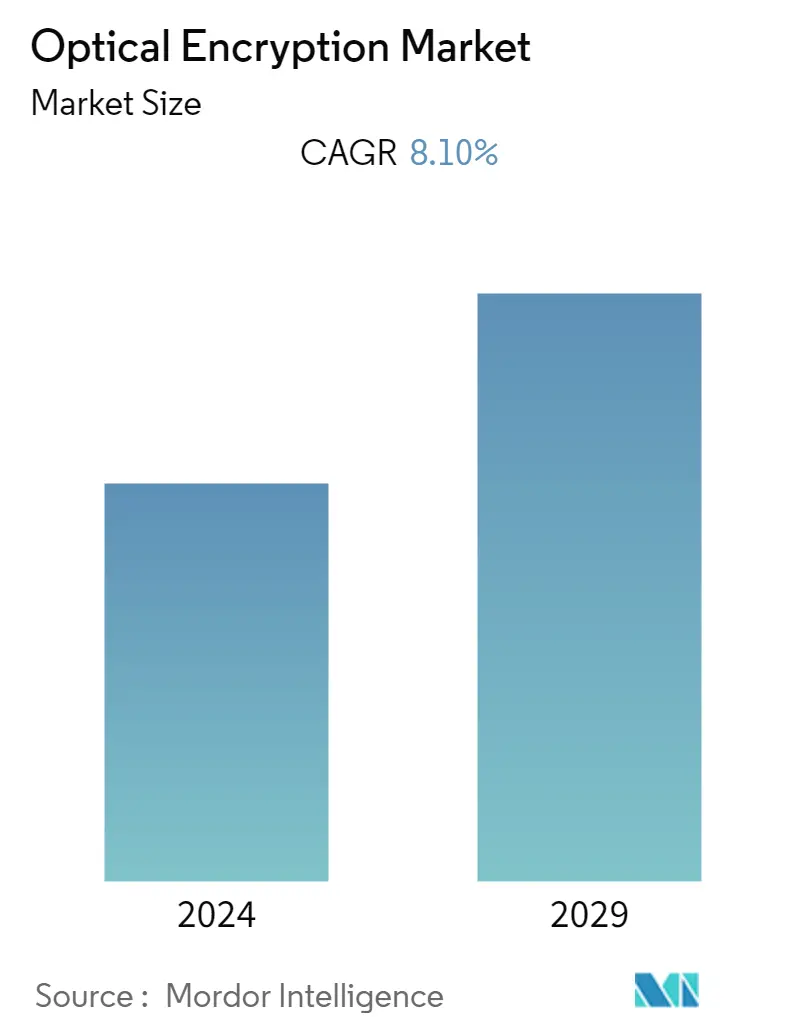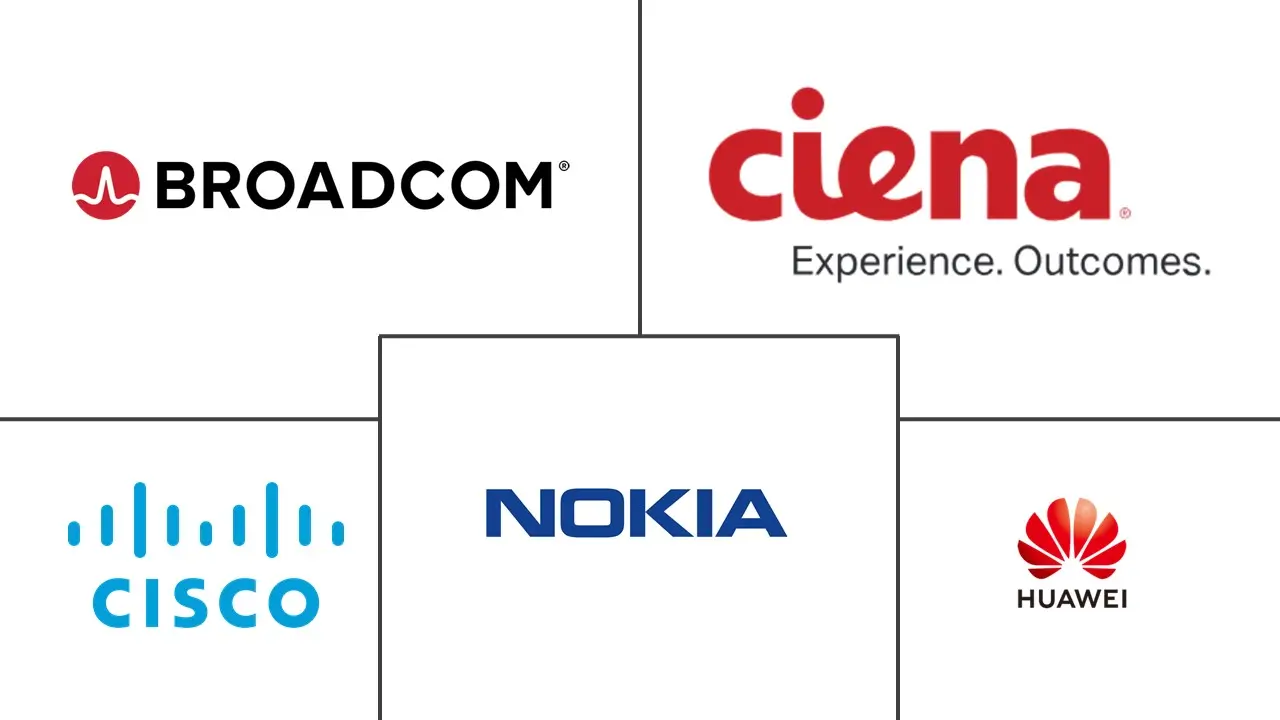Market Size of Optical Encryption Industry

| Study Period | 2019 - 2029 |
| Base Year For Estimation | 2023 |
| CAGR | 8.10 % |
| Fastest Growing Market | Asia Pacific |
| Largest Market | North America |
| Market Concentration | Medium |
Major Players
*Disclaimer: Major Players sorted in no particular order |
Optical Encryption Market Analysis
The optical encryption market is expected to register a CAGR of 8.1%, during the forecast period (2021-2026).
- Owing to the growth of internet devices and the volume of data generated over the course of years, data security has become not just a single feature but rather an increasingly important set of technologies to safeguard the data that is sent across both private and public networks.
- The effective security of the network relies on multiple layers of defense and not just at the core and edge of the network, but also along the network path, while most the organizations focus much of their security at user and application end, which is essential to protect the in-flight data as it travels across the network.
- Although traditional in-flight data encryption solutions have been around for a while, they suffered a number of challenges to cope with current network infrastructures, such as increased latency, delay in management, and hardware compatibility, thereby, adding up to the complexity in maintaining the network.
- Also, the increase of in-flight data to be carried at longer distances across waves, including 10 G, 40 G, and 100 G, among others, has initiated the adoption of optical encryption to protect high-capacity that is be traveled across countries. For instance, in January 2020, BGN Technology, a transfer company of the Ben-Gurion University of Negev, introduced all-optical stealth encryption technology that claimed to be significantly more secure and private for the network transmission of the data center and cloud computing. The solution is said to employ the phase mask that enables it to change the phase of each wavelength.
- Furthermore, the industry-wide adoption of cloud computing application for hosting, processing, and data storage led to an increase in the frequency of sensitive data transferred across the network, which added costs associated with data loss. Increase of data breaches fosters the growth of the market. For instance, 2019 accounted for some of the breaches from major players in various industries, including Zynga, Facebook, Adobe Creative Cloud, and Capital One Financial Corporation, and it reported as much as a leak of 218 million data records.
- Additionally, Industry 4.0 initiatives, such as smart city intiatioas and IoT adoption, and the increasing dependency of organizations, including data center and miltary on the internet network, and the frequency and sophistication of cyberattacks are on the rise, which further elevates the growth the market.
Optical Encryption Industry Segmentation
- The optical encryption refers to the means of securing inflight data present in the transport layer as it travels across the network through optical waves, including 10 G, 40 G, and 100 G, through a fiber-optic cable. This approach helps organizations secure the data irrespective of the application, speed, and protocol.
- The report covers the emerging trends in the optical encryption market segmented by encryption, data rate, and end-user verticals across different regions studied.
| Encryption | |
| Layer1 | |
| Layer 2 | |
| Layer 3 |
| Data Rate | |
| Less 10 G | |
| 10 G-40 G | |
| 40 G-100 G | |
| Greater than 10 G |
| End-user Vertical | |
| Datacenter and Cloud | |
| BFSI | |
| Government and Defence | |
| Healthcare | |
| Energy and Utilities | |
| Retail and E-commerce | |
| Other End-user Verticals |
| Geography | ||||||
| ||||||
| ||||||
| ||||||
| ||||||
|
Optical Encryption Market Size Summary
The optical encryption market is experiencing significant growth driven by the increasing need for robust data security across both private and public networks. As the volume of data generated by internet devices continues to rise, traditional encryption solutions have struggled with challenges such as latency and hardware compatibility, prompting a shift towards optical encryption. This technology is particularly beneficial for protecting high-capacity data transmissions over long distances, such as those used in 10 G, 40 G, and 100 G networks. The adoption of optical encryption is further fueled by the growing reliance on cloud computing and the need to secure sensitive data transfers, as well as the rising frequency and sophistication of cyberattacks. Industries such as finance, government, and data centers are increasingly focusing on enhancing the security of their data over Optical Transport Network (OTN) links, which offer flexible and efficient encryption without compromising service performance.
The Asia-Pacific region is poised to hold a significant share of the optical encryption market, driven by the expansion of networks like 5G, telecom, and smart city initiatives in countries such as China, India, and Malaysia. Despite challenges like the COVID-19 pandemic, China has maintained its leadership in 5G network deployment, which is a core component of its digital infrastructure. Emerging economies in the region are also leveraging their IT industries to establish public cloud-based data centers, further propelling market growth. The market is moderately fragmented, with key players like Nokia Corporation, Juniper Networks Inc., and Cisco Systems Inc. contributing to the competitive landscape. Recent developments, such as Ciena Corporation's coherent optical solution and ADVA's ConnectGuard security technology, highlight the ongoing efforts to meet the rising bandwidth needs and enhance data protection in high-speed networks.
Optical Encryption Market Size - Table of Contents
-
1. MARKET DYNAMICS
-
1.1 Market Overview
-
1.2 Market Drivers
-
1.3 Market Restraints
-
1.4 Value Chain/Supply Chain Analysis
-
1.5 Porter's Five Forces Analysis
-
1.5.1 Threat of New Entrants
-
1.5.2 Bargaining Power of Buyers/Consumers
-
1.5.3 Bargaining Power of Suppliers
-
1.5.4 Threat of Substitute Products
-
1.5.5 Intensity of Competitive Rivalry
-
-
1.6 Assessment of COVID-19 Impact on the Industry
-
-
2. MARKET SEGMENTATION
-
2.1 Encryption
-
2.1.1 Layer1
-
2.1.2 Layer 2
-
2.1.3 Layer 3
-
-
2.2 Data Rate
-
2.2.1 Less 10 G
-
2.2.2 10 G-40 G
-
2.2.3 40 G-100 G
-
2.2.4 Greater than 10 G
-
-
2.3 End-user Vertical
-
2.3.1 Datacenter and Cloud
-
2.3.2 BFSI
-
2.3.3 Government and Defence
-
2.3.4 Healthcare
-
2.3.5 Energy and Utilities
-
2.3.6 Retail and E-commerce
-
2.3.7 Other End-user Verticals
-
-
2.4 Geography
-
2.4.1 North America
-
2.4.1.1 United States
-
2.4.1.2 Canada
-
-
2.4.2 Europe
-
2.4.2.1 Germany
-
2.4.2.2 United Kingdom
-
2.4.2.3 France
-
2.4.2.4 Rest of Europe
-
-
2.4.3 Asia-Pacific
-
2.4.3.1 India
-
2.4.3.2 China
-
2.4.3.3 Japan
-
2.4.3.4 Rest of Asia-Pacific
-
-
2.4.4 Latin America
-
2.4.4.1 Brazil
-
2.4.4.2 Argentina
-
2.4.4.3 Rest of Latin America
-
-
2.4.5 Middle-East and Africa
-
2.4.5.1 United Arab Eminates
-
2.4.5.2 Saudi Arabia
-
2.4.5.3 Rest of Middle-East and Africa
-
-
-
Optical Encryption Market Size FAQs
What is the current Optical Encryption Market size?
The Optical Encryption Market is projected to register a CAGR of 8.10% during the forecast period (2024-2029)
Who are the key players in Optical Encryption Market?
Nokia Corporation, Huawei Technologies Co. Ltd, Broadcom Inc., Cisco System Inc. and Ciena Corporation are the major companies operating in the Optical Encryption Market.

